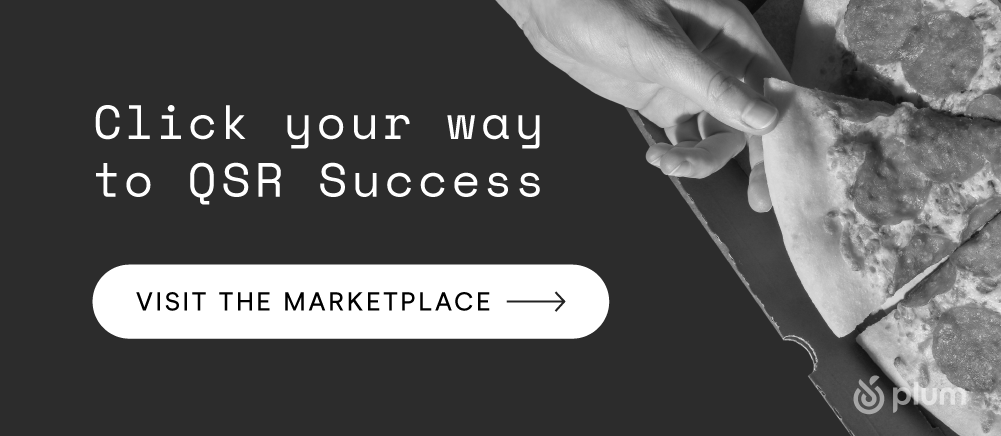
How to Improve QSR Sales: 7 Ready-to-Serve Tips
QSR? More like $SR.
Professionals of the quick-service restaurant industry know something that many casual spectators don’t:
“Fast food” is big business. Huge, actually.
According to the 2021 QSR 50, the top 50 QSR/limited-service companies in the United States combined for a ravenous $217 billion in sales across over 158,000 establishments.
In one year’s time (2020)! In a single country (the United States)!
The figures above include 22,190 Subway units (i.e., restaurants), 15,328 Starbucks units, and 13,682 McDonald’s units. With an average area of about 4,000 square feet, McDonald’s U.S.-based restaurants—by themselves—could cover 950 football fields!
7 Tips for Growing QSR Sales
And big business like this means big competition, something else the average passerby can’t realistically appreciate.
Making it in the QSR industry is nothing less than a blood, sweat, and tears proposition. It’s a difficult sector—requiring ingenuity, discipline, adaptability, hard work, and a “whatever it takes” mentality.
QSR is held in a true survival of the fittest arena, where seemingly small (even incremental) improvements, adaptations, and variables (e.g., a new menu item; high levels of compliance across the chain; weather) can make-or-break a fiscal year.
And considering the giants QSR professionals face every day, any article—like this—that proclaims to know ways QSRs can improve sales probably invites a certain amount of skepticism from hardened industry veterans. Rightly so.
Nevertheless, growth has to start somewhere, and this article shares some tactics we have personally witnessed improve QSR sales.
We serve up 7 such tips below.
Get the foundation right: value and quality
Similarly, make sure patrons are seeing the signs
Look before you leap (with new menu items)
Empathize with customers: a lot has changed
As you’ll see, we base many of these suggestions on survey data and/or the real-world observations of Joe Mislinksi, a Plum team member who has helped many QSRs grow their business over the years.
#1. Get the foundation right: value and quality.
Let’s deal with the self-evident truths first:
- Any set of “tips” for QSRs that doesn’t begin by discussing value and quality is already on shaky ground. They’re the price of entry in the QSR industry. If value and quality isn’t right, nothing else will matter.
- Yet, equally, any set of “tips” for QSRs that does begin by discussing value and quality is in danger of stating the obvious. From A-Z, let’s say Arby’s to Zaxby’s, QSR executives already know that value and quality are square one—with no way to circumvent them.
Consider this: Plum solution-provider Field Agent surveyed 1,213 fast-food customers, July 8, 2022, about their QSR attitudes, behaviors, and purchases.
Respondents were asked, “What are the top factors you consider when choosing a quick service/fast food restaurant?” They could only choose three options.
Not surprisingly, the top two responses were:
- Value/cost (65%)
- Quality/taste (52%)
The third factor, loyalty/points programs and healthy options (tied at 23%), came in almost 30 percentage points behind second-place quality/taste.
Value and quality reign supreme.
And any other attempt to grow QSR sales must launch from a strong foundation of value and quality.
By itself, a solid value-quality combo is possibly enough to maintain your status quo – but probably insufficient to grow your business and eat into your competitors’ market share. That’ll take:
- Innovation
- Taking risks
- Imagining boldly but thinking incrementally
- Paying attention to the details competitors miss
Which leads us to…
#2. Make sure the price is right.
If value/cost is the primary consideration in selecting a limited-service restaurant, then QSRs should do everything within their power to get the price right.
(BTW, Field Agent found price was also the number one factor—surprise, surprise—in patrons’ menu choices, not just their restaurant choices. Four-of-five said value/cost plays an “influential role” in their menu choices, compared to 56% for second-place finisher “previous experiences/repeat purchase.”)
But getting that all-important price right is not just a matter of running price-elasticity and price-sensitivity studies – though, of course, that’s very important.
Getting the price right is also a matter of operations. Put simply: getting the price right on menu boards.
Here’s an all-too-common story across retail: Headquarters decides Widget A (in our case, the Plum Blizzard) will sell for $3.99.
“Go and do likewise,” the QSR exec says to territory managers and individual restaurants.
But do they?
That is, do restaurant and drive-thru menu boards actually reflect the correct price of $3.99?
Chances of 100% compliance across a chain, we’ve learned through the years, is highly unlikely.
And wrong prices usually mean lost sales (or lower profits). Ouch in either case.
This is especially true in an age of changing prices (hello, inflation), or for chains with considerable pricing variation from one market to another.
In most cases, Franchise Operators leeway in setting pricing, especially on promotions. This is why you’ll see the caveat “participation may vary” or “at participating locations”. And then there’s the availability of digital menu boards—making it even easier to change pricing. Obtaining visibility of real time pricing can be difficult.
Want to grow your QSR business? Make pricing compliance a priority across your chain.
Maybe your competitors aren’t?
And, here’s good news, in the crowdsourcing age, a lot of times it’s just a matter of collecting some photos of menu boards across your chain. Or even just spot checking before running a larger audit.
#3. Similarly, make sure patrons are seeing the signs.
Promotional signage is a good example of how, as previously mentioned, thinking incrementally and attending to seemingly small details can be a difference-maker for growth-hungry QSRs.
We all know that promotional signage featuring “punny” marketing copy like “A Cool Treat to Beat the Summer Heat” (a tad trite)—isn’t going to make it rain money.
But that’s not really the point. Such a sign will:
- Drive incremental sales
- Catch the attention of a few passersby
- Upsell guests
- Inform about new menu items
- Support larger marketing campaigns
Multiply benefits like these times 22,190 Subway restaurants—and we’re talking big implications for growing QSR sales.
Indeed, in Field Agent’s survey, 83% of fast-food patrons said they at least sometimes notice promotional signage when they visit QSRs. 83%! Forty-three percent said they “always” or “often” do.
And, at scale, that can be a real difference-maker.
Here, too, execution is everything.
It’s not just a matter of having winsome signs and promoting the right menu items, it’s also a matter of compliance.
And a sign that isn’t there isn’t driving traffic/sales. Mind-blowing, I know.
In July 2022, Field Agent audited 20 McDonald’s restaurants and found signs for frozen fountain drinks at 11 of 20 locations. The question becomes: Were all audited locations supposed to have the signs, or were the signs intended for only certain locations?

Plum-provider Field Agent audited signage at 20 McDonald’s restaurants scattered across the U.S. They asked agents to look for “window cling” signage promoting frozen fountain drinks, as pictured. In all, 11-of-20 locations displayed the signage.
Either way, both explanations add to the variability of promotional signage. And variability encourages mistakes. And mistakes, missed sales.
Joe Mislinksi, client advisor at Field Agent and a veteran of the QSR industry, advises QSRs to make a small investment in assuring local restaurants are deploying signage – in the right place at the right time.
“If the signs are up, you’re going to get sales lift,” Joe said. “If you can audit 100 locations, typically, 67 locations will have perfect execution of POS. Look at the sales results for those locations – you’re getting significant sales lift.
“But what about those other five locations? You’re losing sales lift there – and that can be huge for large chains.”
Joe has witnessed scenarios where even a meager $20 audit (i.e., to find one restaurant with signage and one restaurant without signage), coupled with analysis of restaurant sales for the promotional period, can convince QSR executives to get very serious about signage compliance. During the first week of a promotion, it’s easy to see which locations are not generating sales - audit those - and see they are not executing POS properly, or at all. The ROI is astounding.
#4. Look before you leap (with new menu items).
It’s become a mainstay of the QSR industry: regularly introducing new menu items. And why not?
- If they prove real winners, you’ve got a keeper
- If they don’t get traction, at least you kept things fresh for your customers – and added some novelty and innovation to the menu
In Field Agent’s survey, nearly a quarter of respondents (23%) identified “novelty/newness” as playing an “influential role” in deciding which menu item(s) to purchase from a QSR restaurant.
This isn’t to suggest there isn’t considerable risk with new menu items. They’re often quite costly to develop, launch, and market.
And costly means risky.
So why not mitigate the risk of new product development for your QSR chain? Specifically, why not audition new products for customers—before committing millions of dollars to a national launch?
You may be thinking, “Because it’s expensive and time-consuming. Besides, we use test markets.”
But that’s just pushing the question back. How do you gauge customer sentiment toward those new products in your test markets?
Joe said, “Some QSRs still use the old test kitchen and focus group approach, an expensive and time consuming process. Our clients launch jobs in test markets with real consumers, generating hundreds of data points about value, taste, packaging, color, temperature, flavor profile and much more, in situ. The real world environment yields actionable insights for national rollouts.”
Crowdsourcing solutions are making it much easier – and more cost-effective – to evaluate customers’ attitudes toward new menu items... before a full-scale rollout.
If you want to grow QSR sales, take necessary risks.
#5. Keep the technology coming.
Remember when we thought the internet was only going to change the way we bought CDs?
One look at the QSR industry of today – and wow – how wrong we were.
From DoorDash to self-serve kiosks, the internet is quickly changing the fast food scene.
Field Agent’s survey turned up several insights with implications for technology-use by QSRs. Respondents were asked, “Which of the following do you at least sometimes use to order/receive item from quick service restaurants?”
- Order by app - 69%
- Curbside pickup - 46%
- Self-service kiosks - 45%
- Delivery services - 36%
What a starkly different fast food environment – when 7-in-10 order their food by app, 1-in-2 use curbside pickup and/or self-service kiosks, and 1-in-3 uses a delivery service like Grubhub. Revolutionary.
And, clearly, as indicated by the usage rates, customers approve of all the technological advancement in fast food.
Tech adoption ramped up significantly during the COVID pandemic and show no signs of slowing down. Plus, with Amazon and Grubhub endorsing the new world of frictionless ecommerce, this is a space QSRs are jumping on.
However, in Field Agent’s survey, 79% of respondents said QSR service speed has been slower recently, compared to one year ago. Nineteen percent said it’s been much slower.
Meaning QSRs may have to lean even more on technology to keep the QSR experience a sum-positive. Which leads to another tip…
#6. Optimize the QSR experience.
Think of the QSR experience as the total accumulation of a customer’s interactions—positive and negative—with a QSR, dictated by a customer’s ongoing assessments of the chain’s quality, service, innovation, and value.
Imagine a guest opening the door or driving thru one of these QSR locations. What they see, hear, feel, think, encounter – it’s all part of the QSR experience. And it all has critical bearing on a customer’s loyalty and lifetime value.
The question is: How does a QSR see, hear, feel, think, and encounter as the guest sees, hears, feels, thinks, and encounters? To experience on-the-ground realities as the customer experiences them?
After all, operational realities often differ from plans hatched within HQ boardrooms.
Mystery shopping enters the chat.
Years ago, most big QSRs abandoned their formal mystery shop programs, citing Franchise push-back and the big-brother heavy-handed oversight. Gone are the days of the mystery shopper with the 35 mm camera and the clipboard filled with ten pages of single-spaced checklists, sauntering into the restaurant. Those visits were mostly artificial anyway. Staff knew what was going on.
However, corporate has lost its edge in understanding the true customer journey in-store. From bathroom cleanliness (a very big deal), to store lighting; from the self service beverage station to the parking lot, as well as the overall appearance of the front end, consumers are taking it all in. And then there’s interaction with restaurant staff. Are they trained? Are they greeting the customer correctly? Offering the current promotion? Repeating the order for accuracy? Thanking the customer for their order? All these factors can, and should be measured, and feedback provided to the franchise operator.
#7. Empathize with customers: a lot has changed.
Pandemics. Inflation. Labor shortages. Wayward supply chains.
These are challenging times for QSRs, as the signs at several local fast-food joints make clear: “Please be patient with our staff. We are understaffed.”
And in much the same way that QSRs are requesting empathy from their patrons, let’s not forget that patrons need some empathy as well.
Points (and sales) to the QSR offices and restaurants that not only realize and embrace this reality, but actually use the aforementioned challenges to make inroads with (rather than alienate) customers.
Consider these important insights from Field Agent’s survey of 1,213 fast food customers. Based on their own individual experiences and perceptions…
- 93% said prices on QSR menu items are higher than they were a year ago, with 28% specifically answering “much higher.”
- 84% said the QSRs they patronize are lower-staffed than they were a year ago (21% - “much lower”)
- And, as seen, 79% said wait times at QSR establishments have been slower compared to one year ago (19% - “much slower”)
This is a lot of change.
Q: How do QSRs grow through such challenging times?
A: It begins with empathy – and recognizing just how much has changed for customers and internal stakeholders alike.
We know that perception is reality. How do you change perception? By doing better. You can start by spot checking the little things and rewarding the operations that are doing them right, then publicizing it.
Quick-Serve Solutions for Quick-Service Restaurants
The Plum retail-solutions marketplace has all the ingredients for QSR success. From product evaluations to signage audits, your restaurant is never more than a few clicks away from more QSR sales.
Click below to explore the QSR solutions on Plum.
Mobile Research, Restaurants, Omnichannel, Customer Experience, Market Research, Fast Food, QSR









